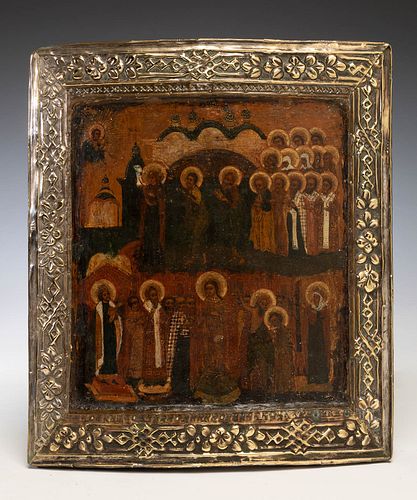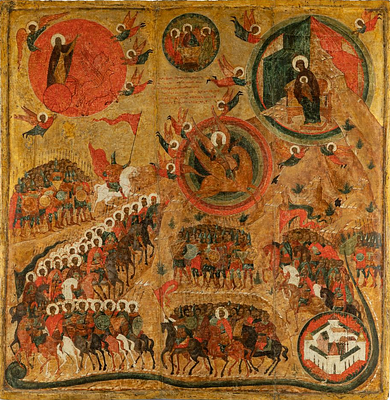Russian school, 18th century. "The Protection of the Mother of God", or "The Virgin of Pokrov". Tempera on panel, silver frame.
Lot 64
About Seller
Setdart Auction House
Carrer Aragó 346
Barcelona
Spain
Setdart Subastas was born in 2004 and is currently the first online art auction in Spain with solidity, prestige and reliability guaranteed by our more than 60,000 users. Setdart has a young, dynamic and enterprising team ready to successfully manage the purchase and sale of art works through custom...Read more
Estimate:
EUR€3,000 - EUR€4,000
$3,125 - $4,166.67
Absentee vs Live bid
Two ways to bid:
- Leave a max absentee bid and the platform will bid on your behalf up to your maximum bid during the live auction.
- Bid live during the auction and your bids will be submitted real-time to the auctioneer.
Bid Increments
| Price | Bid Increment |
|---|---|
| EUR€0 | EUR€10 |
| EUR€200 | EUR€25 |
| EUR€500 | EUR€50 |
| EUR€1,000 | EUR€100 |
| EUR€3,000 | EUR€200 |
| EUR€5,000 | EUR€500 |
| EUR€10,000 | EUR€1,000 |
| EUR€20,000 | EUR€2,000 |
| EUR€50,000 | EUR€5,000 |
About Auction
By Setdart Auction House
Sep 23, 2021
Set Reminder
2021-09-23 10:00:00
2021-09-23 10:00:00
America/New_York
Bidsquare
Bidsquare : RUSSIAN ICONS
https://www.bidsquare.com/auctions/setdart-auction-house/russian-icons-7431
Setdart Auction House sofia@setdart.com
Setdart Auction House sofia@setdart.com
- Lot Description
Russian school, 18th century. "The Protection of the Mother of God", or "The Virgin of Pokrov". Tempera on panel, silver frame. It has a silver frame, 19th century. Measurements: 31 x 27 cm. "The Virgin of Pokrov" is one of the iconographies typical of the Russian Orthodox Church, although it describes events that took place in Constantinople around 910. The story was originally taken from the biography of Andrew of Constantinople, who, together with his disciple Epiphanius, saw the Mother of God flying over the Church of St Mary of Blanquernas, covering the believers with her omophorion as a symbol of protection. On several occasions the story was modified, the last being the version of Bishop Demetrius of Rostov, composed towards the end of the 17th century, who said that among those who saw the miracle were John the Baptist, John the Apostle, Andrew of Constantinople, and King Leo the Wise. It is precisely the iconography of the icon of interest. The significance of this miracle is that the Mother of God protected the city of Constantinople against the Muslim invasion. The prototype of the icon of the protection of the Mother of God, or, in Russian, The Mother of God of Pokrov, was developed around the 14th century, although it would have more impact in later centuries. There are two main types of representation of this scene. One, the older one, belongs to the Novgorod school. The other, the one in front of us, was developed in the Rostov and Suzdal school, and was finally implemented in the Moscow school. The latter typology is distinguished by the Mother of God depicted in the central register in front of the church. She holds the omophorion in her two hands, instead of being held by the two angels, as would be depicted by the Novgorod painters. Apart from the apostles, various martyrs and Andrew of Constantinople, in the lower central register, just below the Virgin, there is a figure typical of the Rostov school, Roman the Méloda, the author of several songs dedicated to the Virgin Mary. It is worth noting that to the right of Roman the Mede, we see Saint Alexius of Rome, or Saint Alexius the Beggar, and the martyr Anisia of Thessaloniki. The composition of the auction icon is very peculiar, as it breaks with the iconographic tradition of depicting the Virgin in the compositional centre of the image, also constructing a symmetrical pattern between the figures. In this case, the composition is divided into two horizontal registers, which have no compositional link between them. And the centre of attention in the upper scene, the main and most important one, is shifted to the left-hand corner, where the Pantocrator is located. All the figures, including the Virgin holding the mophorium, are turned three-quarters towards the appearance of the God. In this way, the iconographic protagonist is completely changed from the Virgin to Jesus Christ. This type of composition is very rare. The icon of interest follows almost identically the composition of one of the most representative icons of the Protection of the Mother of God with this modified composition. It refers to the icon located in the famous St. Basil's Cathedral on Red Square in Moscow. The icon has an antique frame of embossed silver, decorated with natural and floral motifs.
- Shipping Info
-
In-house shipping available. Please inquire at admin@setdart.com.
-
- Buyer's Premium



 EUR
EUR CAD
CAD AUD
AUD GBP
GBP MXN
MXN HKD
HKD CNY
CNY MYR
MYR SEK
SEK SGD
SGD CHF
CHF THB
THB















